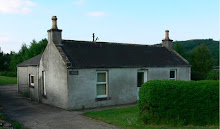 Today I had a meeting with David Stewart who, I've just learned while searching for the photo to the left, is the industry's longest serving Malt Master. He's been working with Glenfiddich for forty-five years.
Today I had a meeting with David Stewart who, I've just learned while searching for the photo to the left, is the industry's longest serving Malt Master. He's been working with Glenfiddich for forty-five years. We discussed the various proposals to ensure that there is still Scotch Whiskey in my barrel in a hundred years time. They included burying it in the ground (which he nixed, it won't breath properly*), having it rotate on a spit (would probably cause more evaporation than it would prevent) and using the feints as the starting point. When distilled spirit comes off the stills there are three spouts in the spirit safe (a beautiful contraption, see below). The middle is the spirit they use - the porridge goldilocks eats , essentially. The other spouts are the feints and the foreshots, which contain spirit at a percentage either too high or too low to use. These are further distilled until they reach the desired middle cut portion of 71%. Feints come in at a percentage in the mid-seventies and the foreshots are typically low sixties. I wondered if we were to start with the feints would we stand a better chance in a hundred years of having a percentage at or above the (current) legal limit of 40 years?Otherwise it's not Scotch at all. Apparently we could start with rubbing alcohol but its not going to taste very good. So we'll go with the middle cut, but not add the standard water, which usually brings it down to 68%.
The barrel will be a large, third use sherry cask, made from Spanish Oak. A first or second use would probably be too intense - the oak would overpower the taste, with it being left to mature for so long. The decline of sherry consumption/production is actually impacting the whiskey industry, with the cost of these barrels skyrocketing. If possible, the barrel staves will be thicker (less porous) and we might reinforce them with stainless steel hoops. I'll have to check with the Cooperage department. (Another thing I've learned - much the way if your name is Smith it is likely someone in your family tree was a Blacksmith, those with the name Cooper likely once made barrels. Fassbinder (as in filmmaker Rainer Werner) means the same thing in German - barrel binder.)
We'll store the barrel in a cool warehouse, with an earthen floor and numerous other casks. The more the better, I'm told.
We also talked about less traditional methods to ensure the spirit meets the legal requirement, things such as cling film on the barrel, wax sealant, etc. etc. I'm of the opinion that you could vacuum seal it and send it the moon and you might get legal whiskey, but we want good whiskey. For whomever it is that gets to drink it.
*there are differing opinions on this. Some think that if it were buried in stones, it would be okay, others worry that water damage to the barrel could still occur.
The photo below is not from Glenfiddich, where photography is discouraged for safety reasons. I'll get some shots during production, but in a monitored, controlled environment. I didn't wanna be a pain in the ass so early on, taking snapshots all the time.


No comments:
Post a Comment